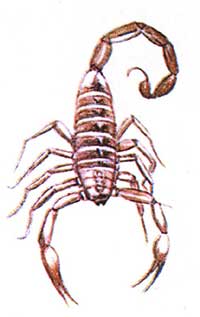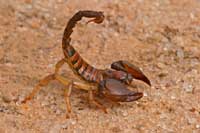
 The scorpion body is divided into two segments: the cephalothorax (also called the prosoma) and the abdomen/opisthosoma. The abdomen consists of the mesosoma and the metasoma. The scorpion body is divided into two segments: the cephalothorax (also called the prosoma) and the abdomen/opisthosoma. The abdomen consists of the mesosoma and the metasoma.
Cephalothorax/prosoma: the scorpion's “head”, comprising the carapace, eyes, chelicerae (mouth parts), pedipalps (claw) and the four pairs of walking legs.
Mesooma: the abomen's front half, is made up of six segments. The first segment contains the sexual organs as well as a pair of vestigial and modified appendages forming a structure called the genital operculum. The second segment bears a pair of featherlike sensory organs known as the pectines; the final four segments each contain a pair of book lungs. The mesosoma is armoured with chitinous plates, the tergites plates upper surface and the sternites plates the lower surface.
Metasoma: the scorpion's tail, comprising six segments (the first tail segment looks like a last mesosoman segment), the last containing the scopion's anus and bearing the telson (the sting). The telson, in turn, consists of the vesicle, which holds a pair of venom (poison) glands and the hypodermic aculeus, the vemon injecting barbex.
Cuticle: this makes a tough armour around the body. In some places it is covered with hairs that act like balance organs. An outer layer that makes them fluoresce green under ultraviolet light is called the hyaline layer. Newly molted scorpions do not glow until after their cuticle has hardened. The fluoresent hyaline layer can be intact in fossil rocks that are hundreds of millions of years old.

 Venom: All species of scorpion possess venom. In general, scorpion venom
is described as neurotoxic in nature. It consists of a variety of
small proteins as well as sodium and potassium cations, which serve
to interfere with neurotransmission in the victim. Scorpions use
their venom to kill or paralyze their prey so that it can be eaten;
in general it is fast acting, allowing for effective prey capture. Venom: All species of scorpion possess venom. In general, scorpion venom
is described as neurotoxic in nature. It consists of a variety of
small proteins as well as sodium and potassium cations, which serve
to interfere with neurotransmission in the victim. Scorpions use
their venom to kill or paralyze their prey so that it can be eaten;
in general it is fast acting, allowing for effective prey capture.
Venom effect on humans: Scorpion venoms are geared towards activity in other arthropods
and therefore most scorpions are relatively harmless to humans;
stings produce only local effects (such as pain, numbness or swelling).
However a few scorpions can be dangerous to humans. Deaths from
scorpion stings normally occur in the young, elderly or infirm.
One symptom of a scorpion sting can include numbing at the injection
site, sometimes lasting for several days. Unless molested, scorpions
are generally harmless and timid and make use of the sting only
for the purpose of killing prey. Generally, they will run from danger
or remain very still.
Venom conservers: It is unknown whether scorpions are venom conservers; however,
the venom is often only used when the prey cannot be subdued with
the claws alone. Many species of scorpions rarely if ever use their
venom, instead relying on their strong bulky pedipalps in prey capture.
How scorpions eat: Scorpions generally use their chela (pincers) to catch the prey initially. Depending on their toxicity of their venom and size of their claws, they will then either crush it or inject it with neurotoxic venom. This will kill or paralyse the prey so the scorpion can eat it. Scorpions have a quite unique style of eating which uses chelicerae. These are small claw like structures which protrude from the mouth, only a handful of other animals have these including vinegaroons. Chelicerae are very sharp and are used to pull small amounts of food off the prey item for digestion. Scorpions can only digest food in a liquid form, any solid matter (fur, exoskeleton, etc) is disposed of by the scorpion.
Suicide myth: The belief that scorpions commit suicide by stinging themselves to death when surrounded by fire is of considerable antiquity and is often prevalent where these animals exist. It is nevertheless untrue since the venom has no effect on the scorpion itself, nor on any member of the same species (unless the venom is injected directly into the scorpion's nerve ganglion). The misconception may derive from the fact that scorpions are cold-blooded: when exposed to intense heat their metabolic processes malfunction. This causes the scorpion to spasm wildly and this spasming may appear as if the scorpion is stinging itself. It is also untrue that alcohol will cause scorpions to sting themselves to death.
 Radiation: It is said that scorpions can survive the radiation that results from the detonation of nuclear weapons. Indeed, scorpions have been observed surviving the radiation from nuclear weapons tests at French test sites in the Sahara . Scorpions are also known to glow when exposed to certain types of ultraviolet radiation such as that which is produced by a blacklight. Radiation: It is said that scorpions can survive the radiation that results from the detonation of nuclear weapons. Indeed, scorpions have been observed surviving the radiation from nuclear weapons tests at French test sites in the Sahara . Scorpions are also known to glow when exposed to certain types of ultraviolet radiation such as that which is produced by a blacklight.
Geographical distribution: Scorpions are almost universally distributed south of 49 ° N and their geographical distribution shows in many particulars a close and interesting correspondence with that of the mammals, including their entire absence from New Zealand. The facts of their distribution are in keeping with the hypothesis that the order originated in the northern hemisphere and migrated southwards into the southern continent at various epochs, their absence from the countries to the north of the above-mentioned latitudes being due, no doubt, to the comparatively recent glaciation of those areas. When they reached Africa, Madagascar was part of that continent; but their arrival in Australia was subsequent to the separation of New Zealand from the Austro-Malayan area to the north of it. Moreover, the occurrence of closely related forms in Australia and South America on the one hand, and in tropical Africa and the northern parts of South America on the other, suggests very forcibly that South America was at an early date connected with Australia by a transpacific bridge and with Africa by a more northern transatlantic tract of land.
Adaptation: In conformity with their wide dispersal, scorpions have become adapted to diverse conditions of existence, some thriving in rainforests, others on open plains, others in sandy deserts and a few even at high altitudes where the ground is covered with snow throughout the winter. In the tropics, they aestivate at times of drought; and in the Alps, they pass the cold months of the year in a state of hibernation.
Scorpions in USA: In the United States, scorpions are most common in southern Arizona and in a swath extending through central Texas and central Oklahoma. The common striped scorpion, Centruroides vittatus, reaches from northwest Mexico to southern Colorado, Kansas, southern Missouri and Mississippi. Species of the genus Vaejovis are found from Florida north to Maryland, the Carolinas, and Tennessee and as far west as Oregon and California. Paruroctonus boreus is found through the Northwest US and into Canada. Scorpions can be found in 31 different states in the US, including Hawai'i (Isometrus maculatus).
Scorpions in England: Five colonies of scorpions (Euscorpius flavicaudis) have established themselves in southern England having probably arrived with imported fruit from Africa, but the number of colonies could be lower now because of the destruction of their habitats. This scorpion species is small and completely harmless to humans.

Scorpions generally reproduce sexually and all species have male
and female individuals. Mating starts with the male and female locating
and identifying each other using a mixture of pheromones and vibronic
communication; once they have satisfied each other that they are
of opposite sex and of the correct species, mating can commence.
The courtship starts with the male grasping the female’s claws
with his own; the pair then performs a "dance" called
the "promenade à deux". In reality this is the
male leading the female around searching for a suitable place to
deposit his spermatophore. The courtship ritual can involve several
other behaviours, probably meant as a means of pacifying the female.
When he has identified a suitable location, he deposits the spermatophore
and then guides the female over it. This allows the spermatophore
to enter her genital opening, which triggers release of the sperm,
thus fertilising the female. The mating process can take from 1
to 25+ hours and depends on the ability of the male to find a suitable
place to deposit his spermatophore. If mating goes on for too long,
the female may eventually break off the process.
Once the mating is complete, the male and female quickly separate.
The male will generally retreat quickly, most likely to avoid being
cannibalised by the female, although sexual cannibalism is infrequent
with scorpions.
Young scorpions are born one by one, and the brood is carried about
on its mother's back until the young have undergone at least one
moult. Before the first moult, scorplings cannot survive naturally
without the mother, depending on her for protection and to regulate
their moisture levels. The size of the litter depends on the species
and can range from three to over 100 corplings.
The young resemble their parents in a general way. Growth is accomplished
by periodic shedding of the exoskeleton. A scorpion's developmental
progress is measured in instars (how many moults it has undergone).
Generally, scorpions require between five to seven moults to reach
maturity. When it emerges from a moult, the scorpion’s new
exoskeleton is soft, making the scorpion highly vulnerable to attack.
The scorpion must constantly stretch while the new exoskeleton hardens
to ensure that it can move when the hardening is complete.
Scorpions have very variable lifespans and the actual lifespan
of most species is not known; however, the range is approximately
4-25 years 25 years being the maximum reported life span.
All text is available under the terms
of the GNU Free Documentation License
|

